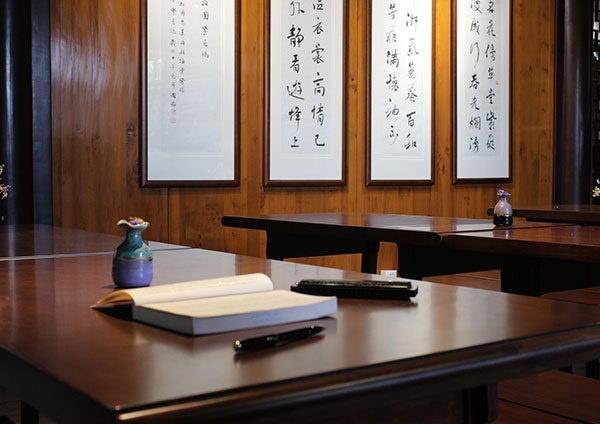Calligraphy culture output and calligraphy international communication
Time 2019-11-12
Calligraphy should stand in the forest of world art, its development can not be separated from the recognition and re examination of calligraphy art in the international art circle. At present, the domestic calligraphy exhibition and theoretical research work are advancing in depth, but the output of calligraphy culture and international exchange are still a weak link. The analysis and promotion of international communication of Chinese calligraphy will help scholars at home and abroad to understand Chinese culture from a deeper level, grasp the essential connotation and artistic characteristics of calligraphy art, enhance the pertinence and purpose of foreign scholars' research on Chinese calligraphy art, and then provide a good platform and way for calligraphy culture output. From this point of view, the international communication and output of calligraphy culture can effectively enhance the brand value and cultural value of Chinese calligraphy, and form the soft power of calligraphy culture and the international discourse status of calligraphy.
The failure of Chinese character culture circle and the reconstruction of calligraphy culture
"Chinese culture circle" is also known as "Confucian culture circle", which refers to the region that is influenced by Chinese Confucianism and art culture in history and still uses Chinese culture in history or in modern times to identify with Chinese cultural spirit. Generally, it includes Hong Kong, Macao and Taiwan in mainland China, Japan, North Korea, South Korea, East Asia and parts of Southeast Asia. In a broad sense, the areas affected by cultural China also include some regions and people in Europe and the United States.
Nowadays, when the United States uses "smart power" to stir up the cultural circle of Chinese characters to challenge China and its "cultural strategy" towards China, the situation in the South China Sea and the East China Sea shows that the millennium long "cultural circle of Chinese characters" has been eliminated in more than half a century of "de Sinicization", and the "cultural circle of Chinese characters" is being replaced by the "cultural circle of America", which leads to China's current encounter with cultural soft power. He was repeatedly constrained. Therefore, we should take a more active cultural attitude to spread Chinese character culture and calligraphy overseas. In a word, when we are making great progress in cultural development, we should strive to export Chinese calligraphy culture overseas, so that the world can understand China, understand China, appreciate China, and make it possible for Chinese culture and calligraphy to become more and more cosmopolitan.
Feng Huiling, vice president of Renmin University of China, presided over an investigation topic - "the sorting of cultural elements of China's national image". The investigation team conducted a large-scale overseas investigation. The respondents included politicians and entrepreneurs with greater social influence in 50 countries. The survey also referred to nearly 3000 domestic and foreign media reports. The results showed that Chinese calligraphy has surpassed Peking Opera as the most favorite Chinese art for foreigners.
Over the years, I have spread Chinese culture and calligraphy art in the United States, Britain, Germany, France, Switzerland, Tanzania, Japan, South Korea, Singapore, Malaysia, Indonesia, Hong Kong, Macao and Taiwan. When I gave a speech at the University, Joe F. Dede, vice president of the University, said: "the opening ceremony of the Olympic Games in China makes Chinese calligraphy appreciated and valued by the international community. American calligraphers should also develop western calligraphy, conduct various exchanges with Chinese calligraphy in the eastern countries, and make people enjoy the beauty and spirit of writing." I replied: "the ancient Chinese calligraphy culture used to be the cultural treasure of the Chinese character culture circle. In today's globalization, we should develop new cultural space with the development of Confucius institutes all over the world. I have come to the United States to have on-the-spot exchanges with dozens of university teachers and students in the United States, hoping to reduce the misreading of Chinese culture by western centralism, and to jointly reveal the Enlightenment of Chinese culture to mankind in the era of globalization. ". There are great differences between Chinese culture and American culture, which can not be balanced by conquering one side and surrendering the other, but only seeking common ground while reserving differences. In fact, there are many ways and models to realize modernization in the world, not only in the west, but also in China. Chinese modernity can't be a copy of Western modernity. Chinese modernity will prove that it is rooted in its own long history and culture in terms of culture, value, religion and system. The rise of China is rewriting the history of mankind. The rising China is no longer a marginal country, but a great power participating in changing the world.
I have lectured in London and Edinburgh in the UK many times, and also in Tanzania in Africa. I really feel that although in the process of globalization, everyone is singing karaoke, eating McDonald's and hamburgers, drinking Coca Cola and enjoying the modern life style brought by the airport and railway, we can never bring Europe, Africa and me together We are mixing up in Asia. So what's the mark of Britain? There is a towering sculpture at the crossroads of every city. There will be a general or a great man riding on the top of the sculpture. Since the middle ages, all the important wars, great men and thinkers in British history have made history come to the present through this way. It can be said that British sculpture represents the continuation tradition of the integration of Western sculpture and architectural spirit since ancient Greece. The most obvious signs of African culture are wood carvings, thick lips and long wood carvings carved out of black wood. What about Asia? It can be said that calligraphy is the most important cultural symbol in Asia. Oriental Calligraphy can be seen everywhere in airports, flags, hotels and shop signs. Of course, there is the chopsticks culture in China, which is also different from the eastern culture, European culture and African culture.
Recently, the BBC commissioned global scanning to carry out a national image survey, so that countries around the world can assess the positive and negative impact on the world from the standards of Britain, Canada, China, France, India, Iran, Israel, Japan, North Korea, Russia, the United States and other countries. According to the survey of nearly 30000 middle-level and high-level people from different countries, the international image of the above-mentioned countries was ranked and published by time weekly. The number of recognized votes: 54% in Canada and Japan, 50% in France, 45% in Britain and 42% in China. China's national image ranks fifth. There are two phenomena worthy of attention in this international non-governmental evaluation: the first is that the United States is ranked in the top five; the second is that Japan's national image has become the first place in parallel with Canada. As far as the United States is concerned, its military intervention in various parts of the world has stretched out too much, and its obvious hegemonic international behavior has led to a rise in the world's negative evaluation, but this does not mean that the world does not attach importance to the United States, on the contrary, the American voice in the world still cannot be underestimated. As far as Japan is concerned, despite its poor reputation among Asian countries, it has become an isolated negative image among Asian countries due to its problems of World War II, Yasukuni Shrine, history textbooks, comfort women, and its ambition to annex Diaoyu Island, but it has not attracted the general attention of the international community, so its evaluation of Japan in the international community is still on the high side. "Why is Japan, the world's No. 1 country in terms of national image, so bad in China? The Japanese nation is regarded as a shameless nation by many people. Why is its national image ranked first in the world? " China has been committed to economic development for a long time, and the lack of cultural output, especially calligraphy cultural output, is an important reason. This has led to China's still less than half of the positive international comments, indicating that some countries still have a cold war consciousness and are wary of China's peaceful rise. The strong worldwide expansion of the United States has led to worldwide economic, political, military and cultural conflicts. The Islamic civilization in West Asia and Central Asia and the Indian civilization in South Asia have been integrated into the world order of Western civilization in economic system, while the Chinese civilization in East Asia has rejected the western centralism world economic colonial system, and has made its own way in the human modernization movement.
Another issue worthy of attention is that neighboring countries, especially Japan and South Korea, have begun to consciously compete with China for the representative status of East Asian civilization. Japanese archaeologist Shinichi Fujimura has forged for a long time, at the expense of his academic reputation to artificially push Japanese history upward. South Korea and India have constantly put forward the ownership of four major inventions, including printing and papermaking 。 This prompted me to think, why do these countries have to do articles on cultural issues? A real great country must first establish its own cultural identity in order to make an independent voice on the world stage, which is not easy compared with economic construction.
In the new century's multi polar international discourse platform, we should seize the opportunity to reshape the unique and charming image of China. The shaping of this international image is closely related to our balanced grasp of the modernity and nativity of China's image. Without the modernization of science and technology, we cannot identify with the progress of world civilization, and without the continuity of our own cultural tradition, we cannot identify with the local subject of civilization. Only when the whole people improve their values and accomplishments, and the whole society's good cultural quality, can China's peaceful rise be unstoppable, and the improvement of China's image be sustainable.


